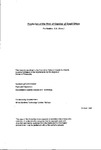Prediction of the Risk of Capsize of Small Ships
| dc.contributor.author | Deakins, Eric | |
| dc.contributor.other | Faculty of Science and Engineering | en_US |
| dc.date.accessioned | 2013-10-24T11:43:53Z | |
| dc.date.available | 2013-10-24T11:43:53Z | |
| dc.date.issued | 1988 | |
| dc.identifier | NOT AVAILABLE | en_US |
| dc.identifier.uri | http://hdl.handle.net/10026.1/2343 | |
| dc.description.abstract |
The lack of a necessary rational framework for assessing ship stability was the main concern of this research. The aim was to develop a rational philosophy and a logical procedure of assessing intact stability in order to ensure a consistent and unified approach to design for operation and for survival. The method uniquely brings together a linearised analysis for assessing a potentially dangerous roll motion with a probabilistic assessment of ship performance in rough seas on a standard test-track. This represents a significant advance on previous research. A novel feature of the analysis was that prediction of the extreme capsize roll motion was not attempted per se. Instead a reduced level of roll response termed "potentially dangerous" roll motion was selected (based on discussions with seagoing personnel) beyond which there was evidence that loss of the vessel is likely. Validation of the linear spectral analysis used in the simulations was performed using full scale trial results of a fisheries protection vessel. Provided that measured values of roll damping coefficient were used, the predicted values of extreme roll closely matched the maximum values experienced on sea trials up to the chosen value of critical roll angle of 30 degrees. Particular attention was paid to the realistic modelling of total system behaviour in rough seas. Families of wave spectra were used to represent the complete range of wave conditions encountered in nature. Avoidance and pacifying seamanship were incorporated based on the results of available trials data and discussions with serving masters. Independent (Bernoulli) trials procedures were used to calculate the cumulative probability of a critical roll motion being exceeded at least once during the vessel's passage through the test-track. The value of critical motion exceedance obtained was 5x10ˉ² for the fisheries protection vessel which has a large metacentic height and is reported to have good seakeeping characteristics. | en_US |
| dc.description.sponsorship | British Maritime Technology Umited, Feltham | en_US |
| dc.language.iso | en | en_US |
| dc.publisher | University of Plymouth | en_US |
| dc.title | Prediction of the Risk of Capsize of Small Ships | en_US |
| dc.type | Thesis | |
| dc.identifier.doi | http://dx.doi.org/10.24382/3784 |
Files in this item
This item appears in the following Collection(s)
-
01 Research Theses Main Collection
Research Theses Main


